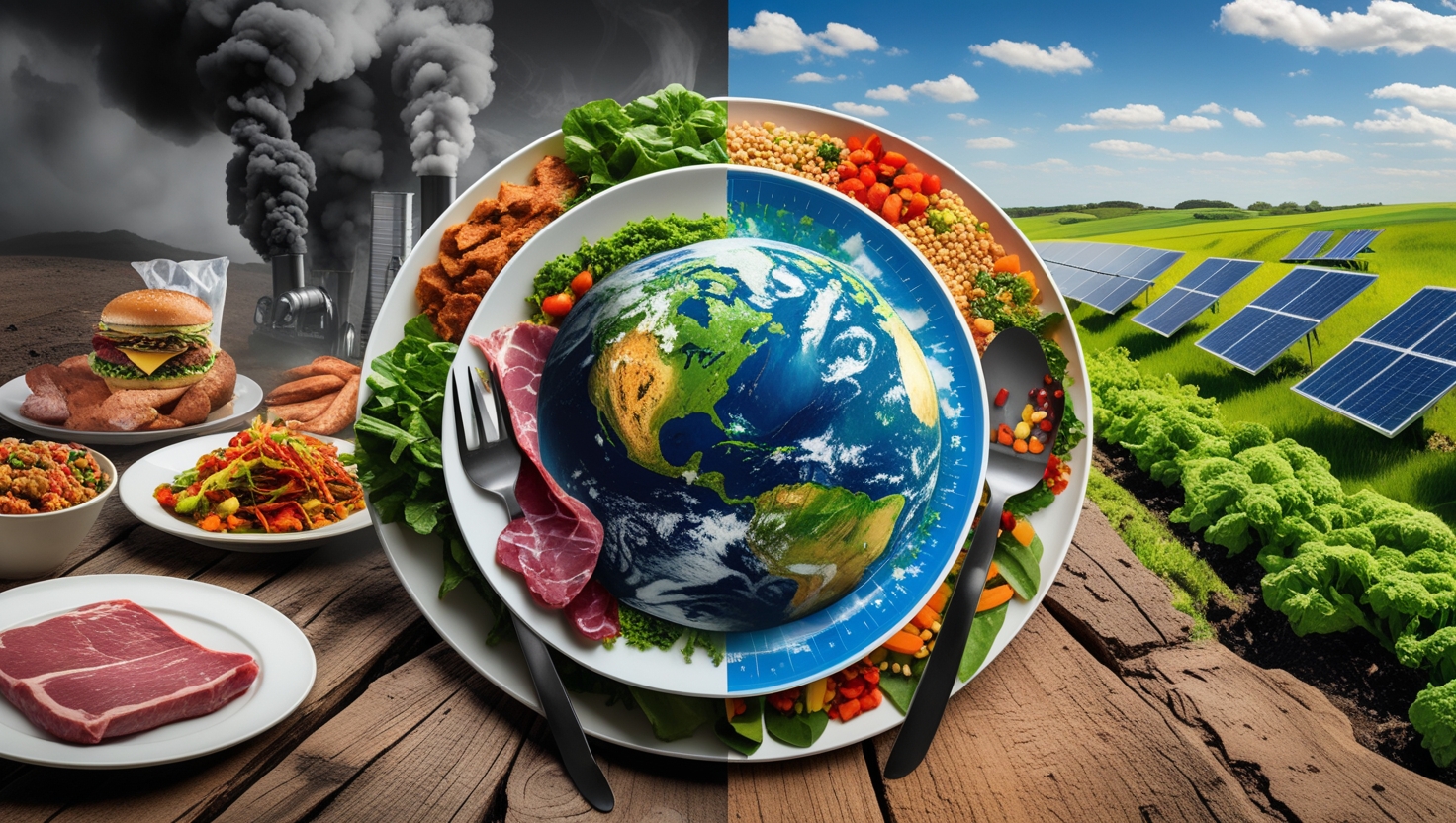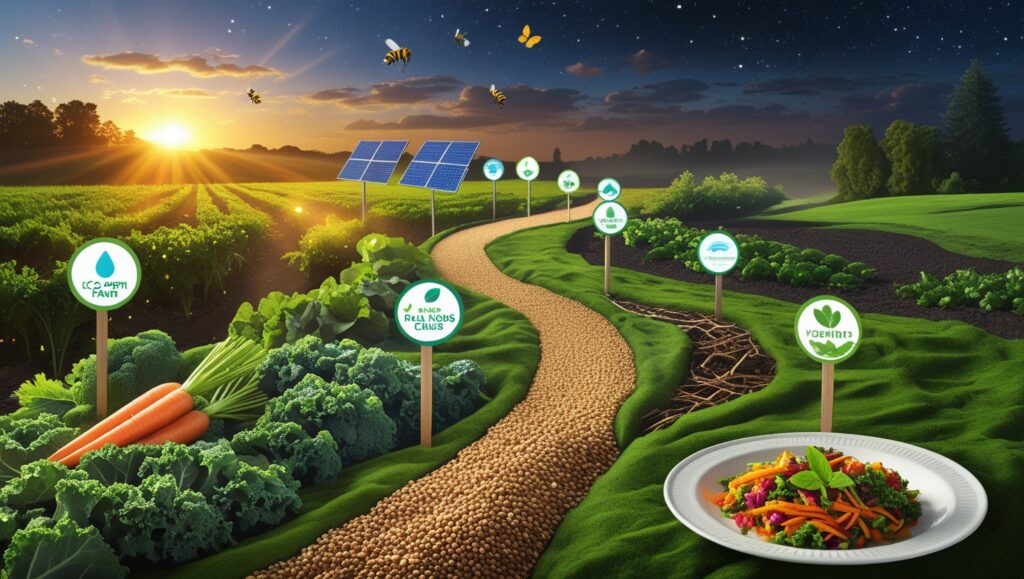From Farm to Fork : How Plant Based Eating Reduces Our Ecological Footprint

Here, We’re looking at our food choices and their impact on greenhouse gas emissions. Also, We explore how the foods we consume can impact climate change gases, and explore options to make eco-friendly dietary decisions.
What is Climate Change?
Climate change refers to long-term shifts in temperatures and weather patterns. Such shifts can be natural, due to changes in the sun’s activity or large volcanic eruptions. But since the 1800s, human activities have been the main driver of climate change, primarily due to the burning of fossil fuels like coal, oil and gas.
Burning fossil fuels generates greenhouse gas emissions that act like a blanket wrapped around the Earth, trapping the sun’s heat and raising temperatures.
The main greenhouse gases that are causing climate change include carbon dioxide and methane. These come from using gasoline for driving a car or coal for heating a building, for example. Clearing land and cutting down forests can also release carbon dioxide. Agriculture, oil and gas operations are major sources of methane emissions. Energy, industry, transport, buildings, agriculture and land use are among the main sectors causing greenhouse gases.
How We experience Climate Change in our daily life?
How what we eat impacts the environment
Our eating habits can significantly affect the environment. For example, transporting food across long distances, along with the need for packaging and preservation, uses considerable energy and resources, leading to greenhouse gas emissions. Diets rich in meat and dairy usually demand more resources and leave a larger environmental impact compared to plant-based eating. This is because producing animal-based foods consumes more land, water, and energy than growing plant-based eating alternatives.
Plant Based Eating
Plant based or plant-focused eating emphasize consuming foods that come mainly from plants. This includes not just fruits and vegetables, but also whole grains, legumes, beans, nuts, seeds, and plant-based oils. Following this approach doesn’t require you to be vegetarian or vegan or to completely avoid meat and dairy. Instead, it means that a larger portion of your meals consists of plant-derived foods.
“A plant based eating strengthens your immune system to protect you against germs and microorganisms.”
The vitamins and minerals, phytochemicals and antioxidants in plants help keep your cells healthy and your body in balance by toxins from pollution, processed food, bacteria, viruses and more so that your immune system can function at its best.

Benefits of Plant Based Eating
Better Nutrition:
Plants are healthy. Fruits and Vegetables are rich in vitamins, minerals, antioxidants and fiber. Fiber is a nutrient that most of us don’t get enough of, it’s good for your heart, your gut and your blood sugar.
Plant Based eating improves the health of your gut so you are better able to absorb the nutrients from food that support your immune system and reduce inflammation. Fiber can lower cholesterol and stabilize blood sugar and it’s great for good bowel management.
A healthier Heart:
Plant Based eating may reduce risk of cardiovascular disease, and may improve other risk factors for heart disease by lowering your blood pressure and cholesterol, and improving your blood sugar control.
Maintain Healthy Weight:
Plant Based Eating is highly effective for weight loss. Plant-based diets are low in energy density and high in complex carbohydrate, fiber, and water, which may increase satiety and resting energy expenditure.”
Lower Diabetes Risk
Plant based Eating improves insulin sensitivity, so that Plant Based diet can help prevent and treat type 2 diabetes. Plant based foods also have more fiber than animal foods, and increased fiber intake has been associated with a decreased diabetes risk.
Decreased Cancer Risk:
Regularly eating plant based foods, fruits, veggies, legumes, and grains is associated with a lower cancer risk. Phytochemicals in plants have also been shown to prevent from throat cancer.
Different Types Of Plant Based Eatings:
plant-based eatings are as follows:
- emphasizes whole, minimally processed foods
- limits or avoids animal products
- focuses on plants, including vegetables, fruits, whole grains, legumes, seeds, and nuts, as the majority of your diet
- limits refined foods, like added sugars, white flour, and processed oils
- pay special attention to food quality, with many proponents of the WFPB diet promoting locally sourced, organic food whenever possible
People who follow vegan diets avoid consuming any animal products, including:
- dairy
- meat
- poultry
- seafood
- eggs
- honey
Environmental Benefits of Plant Based Eating
What we eat, and how that food is produced, affects our health but also the environment. Food needs to be grown and processed, transported, distributed, prepared, consumed, and sometimes disposed of. Each of these steps creates greenhouse gases that trap the sun’s heat and contribute to climate change. The largest chunk of food-related greenhouse gases comes from agriculture and land use. This includes, for instance:
- methane from cattle’s digestive process,
- nitrous oxide from fertilizers used for crop production,
- carbon dioxide from cutting down forests for the expansion of farmland,
- other agricultural emissions from manure management, rice cultivation, burning of crop residues, and the use of fuel on farms.
A much smaller share of the greenhouse gas emissions of food are caused by:
- refrigeration and transport of food,
- industrial processes such as the production of paper and aluminum for packaging,
- the management of food waste.
Cutting emissions from the food sector calls for action across the entire supply chain—from farmers to consumers. One effective strategy is shifting to plant based eating that emphasize plant proteins like beans, lentils, chickpeas, nuts, and whole grains, while reducing the intake of animal-based foods such as meat and dairy, along with saturated fats like butter, cheese, milk, coconut oil, and palm oil. This shift can substantially lower greenhouse gas emissions, especially in industrialized nations with high meat consumption.
Emerging protein alternatives—such as plant-based meat and dairy, insect protein, and lab-grown or cultivated meat—are gaining popularity and attracting investment, innovation, and consumer interest.
However, animal-based foods continue to play a critical role in nutrition, food security, and rural livelihoods. Emission reductions in livestock farming can be achieved through better feeding methods that lower methane emissions during digestion and improve manure management. Smaller, more efficient herds also contribute to lower emissions. Additionally, sustainable practices like rotational grazing, improved fertilizer use, and rehabilitating degraded land can further reduce agricultural emissions.
Curbing food waste is equally vital. Around 1 billion tons of food—17% of what’s available to consumers globally—is discarded each year. The production, transport, and decay of this wasted food contribute 8–10% of global greenhouse gas emissions—almost five times more than the aviation industry. If food waste were a country, it would rank as the third-largest emitter worldwide.
“Go with Plant Based Eating : Make Your body Healthy, and Make Planet Healthy.”
